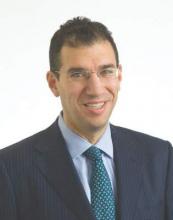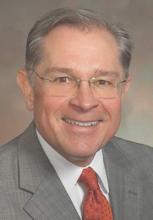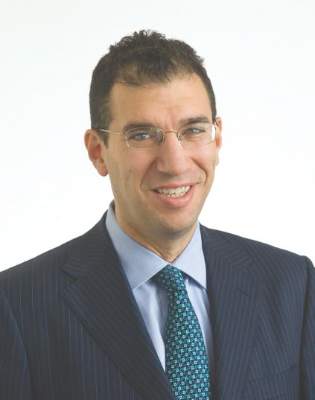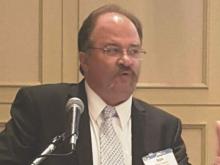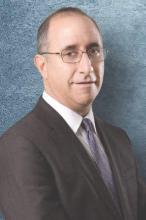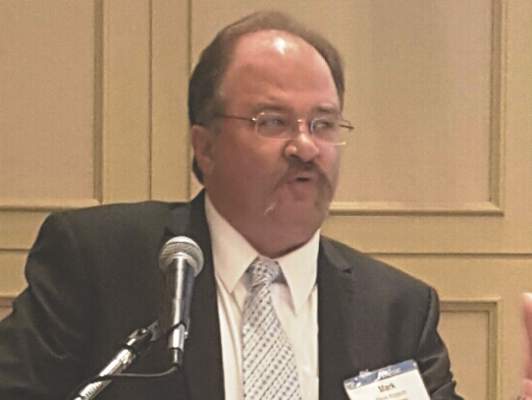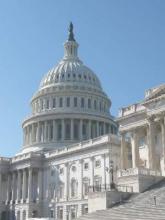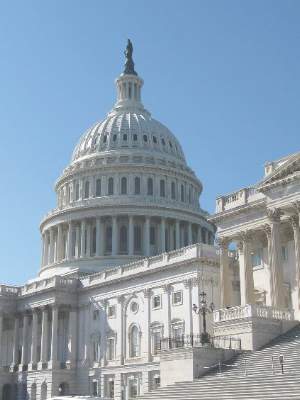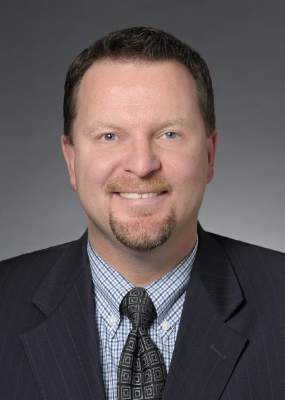User login
President Obama calls for ‘moon shot’ to cure cancer
President Obama is calling on America’s medical research industry to cure cancer.
In his final State of the Union address, delivered Jan. 12, Mr. Obama compared this moment to that embraced by the nation in response to the Soviet Union’s foray into space: Within 12 years, Americans stepped foot on the Moon.
“Last year, Vice President [Joe] Biden said that, with a new moon shot, America can cure cancer,” President Obama said. “Tonight, I’m announcing a new national effort to get it done.”
No further details were given, except that Vice President Biden is being put “in charge of Mission Control,” after noting his role in getting increased funding in the recent budget for the National Institutes of Health.
The American Association for Cancer Research (AACR) applauded the commitment to curing cancer.
“We have indeed reached an inflection point, where the number of discoveries that are being made at such an accelerated pace are saving lives and bringing enormous hope for cancer patients, even those with advanced disease,” Dr. José Baselga, AACR president, said in a statement. “Now is the time for a major new initiative in cancer science that supports and builds upon our basic science foundation while translating these exciting scientific discoveries into improved treatments for cancer patients, such as in the areas of genomics, precision medicine, and immuno-oncology.”
The AACR said that members of its organization were among a group that met with Vice President Biden on Jan. 8 to discuss the state of cancer research.
The American Society of Clinical Oncology concurred.
“With nearly 1.7 million people in the United States diagnosed with cancer each year, and the incidence of cancer expected to rise to 2.3 million cases per year by 2030, it is imperative that we do all we can to bring more effective treatments from the laboratory bench to the patient’s bedside as quickly as possible,” Dr. Richard L. Schilsky, ASCO chief medical officer, said in a statement. “We must recommit to vastly speeding the discovery of new cancer treatments and enabling the possibility of precision medicine for every individual with cancer.”
The annual address to Congress was light on health care issues, with President Obama acknowledging U.S. leadership in helping to halt the Ebola epidemic and adding that “we are on track to end the scourge of HIV/AIDS, and we have the capacity to accomplish the same thing with malaria – something I’ll be pushing this Congress to fund this year.”
Rather, President Obama focused more on the economy and the security of the nation, as well as calling on Americans to be more active in voting and the overall political process.
President Obama is calling on America’s medical research industry to cure cancer.
In his final State of the Union address, delivered Jan. 12, Mr. Obama compared this moment to that embraced by the nation in response to the Soviet Union’s foray into space: Within 12 years, Americans stepped foot on the Moon.
“Last year, Vice President [Joe] Biden said that, with a new moon shot, America can cure cancer,” President Obama said. “Tonight, I’m announcing a new national effort to get it done.”
No further details were given, except that Vice President Biden is being put “in charge of Mission Control,” after noting his role in getting increased funding in the recent budget for the National Institutes of Health.
The American Association for Cancer Research (AACR) applauded the commitment to curing cancer.
“We have indeed reached an inflection point, where the number of discoveries that are being made at such an accelerated pace are saving lives and bringing enormous hope for cancer patients, even those with advanced disease,” Dr. José Baselga, AACR president, said in a statement. “Now is the time for a major new initiative in cancer science that supports and builds upon our basic science foundation while translating these exciting scientific discoveries into improved treatments for cancer patients, such as in the areas of genomics, precision medicine, and immuno-oncology.”
The AACR said that members of its organization were among a group that met with Vice President Biden on Jan. 8 to discuss the state of cancer research.
The American Society of Clinical Oncology concurred.
“With nearly 1.7 million people in the United States diagnosed with cancer each year, and the incidence of cancer expected to rise to 2.3 million cases per year by 2030, it is imperative that we do all we can to bring more effective treatments from the laboratory bench to the patient’s bedside as quickly as possible,” Dr. Richard L. Schilsky, ASCO chief medical officer, said in a statement. “We must recommit to vastly speeding the discovery of new cancer treatments and enabling the possibility of precision medicine for every individual with cancer.”
The annual address to Congress was light on health care issues, with President Obama acknowledging U.S. leadership in helping to halt the Ebola epidemic and adding that “we are on track to end the scourge of HIV/AIDS, and we have the capacity to accomplish the same thing with malaria – something I’ll be pushing this Congress to fund this year.”
Rather, President Obama focused more on the economy and the security of the nation, as well as calling on Americans to be more active in voting and the overall political process.
President Obama is calling on America’s medical research industry to cure cancer.
In his final State of the Union address, delivered Jan. 12, Mr. Obama compared this moment to that embraced by the nation in response to the Soviet Union’s foray into space: Within 12 years, Americans stepped foot on the Moon.
“Last year, Vice President [Joe] Biden said that, with a new moon shot, America can cure cancer,” President Obama said. “Tonight, I’m announcing a new national effort to get it done.”
No further details were given, except that Vice President Biden is being put “in charge of Mission Control,” after noting his role in getting increased funding in the recent budget for the National Institutes of Health.
The American Association for Cancer Research (AACR) applauded the commitment to curing cancer.
“We have indeed reached an inflection point, where the number of discoveries that are being made at such an accelerated pace are saving lives and bringing enormous hope for cancer patients, even those with advanced disease,” Dr. José Baselga, AACR president, said in a statement. “Now is the time for a major new initiative in cancer science that supports and builds upon our basic science foundation while translating these exciting scientific discoveries into improved treatments for cancer patients, such as in the areas of genomics, precision medicine, and immuno-oncology.”
The AACR said that members of its organization were among a group that met with Vice President Biden on Jan. 8 to discuss the state of cancer research.
The American Society of Clinical Oncology concurred.
“With nearly 1.7 million people in the United States diagnosed with cancer each year, and the incidence of cancer expected to rise to 2.3 million cases per year by 2030, it is imperative that we do all we can to bring more effective treatments from the laboratory bench to the patient’s bedside as quickly as possible,” Dr. Richard L. Schilsky, ASCO chief medical officer, said in a statement. “We must recommit to vastly speeding the discovery of new cancer treatments and enabling the possibility of precision medicine for every individual with cancer.”
The annual address to Congress was light on health care issues, with President Obama acknowledging U.S. leadership in helping to halt the Ebola epidemic and adding that “we are on track to end the scourge of HIV/AIDS, and we have the capacity to accomplish the same thing with malaria – something I’ll be pushing this Congress to fund this year.”
Rather, President Obama focused more on the economy and the security of the nation, as well as calling on Americans to be more active in voting and the overall political process.
A New Schedule Could Be Better for Your Hospitalist Group
Present “hospitalist” in a word association exercise to a wide range of healthcare personnel in clinical and administrative roles, and many would instantly respond with “seven-on/seven-off schedule.”
Some numbers from SHM’s 2014 State of Hospital Medicine report:
- 53.8%: Portion of hospitalist groups using a seven-on/seven-off schedule.
- 182: Median number of shifts worked annually by a full-time hospitalist (standard contract hours, does not include “extra” shifts).
- 65%: Portion of groups having day shifts that are 12.0–13.9 hours in length.
These numbers suggest to me that, at least outside of academia, the standard hospitalist is working 12-hour shifts on a seven-on/seven-off schedule. And that mirrors my experience working on-site with hundreds of hospitalist groups across the country.
In other words, the hospitalist marketplace has spoken unambiguously regarding the favored work schedule. In some ways, it is a defining feature of hospitalist practice. In the same way that a defining characteristic of Millennials is devotion to social media and that air travel is associated with cramped seats, this work schedule is a defining characteristic for hospitalists.
Schedule Benefits? Many …
There is a reason for its popularity: It is simple to understand and operationalize, it provides for good hospitalist-patient continuity, and having every other week off is often cited as a principle reason for becoming a hospitalist (in many cases, it might only take a clerk or administrator a few hours to create a group’s work schedule for a whole year). Many hospitalist groups have followed this schedule for a decade or longer, and while they might have periodically discussed moving to an entirely different model, most have stuck with what they know.
I’m convinced this schedule will be around for many years to come.
Not Ideal in All Respects
Despite this schedule’s popularity, I regularly talk with hospitalists who say it has become very stressful and monotonous. They say they would really like to change to something else but feel stuck by the complexity of alternative models and the difficulty achieving consensus within the group regarding what model offers enough advantages—and acceptable costs—to be worth it.
They cite as shortcomings of the seven-on/seven-off schedule:
- It can be a Herculean task to alter the schedule to arrange a day or two off during the regularly scheduled week. They often give up on the effort, and over time, this can lead to some resentment toward their work.
- There is a tendency to adopt a systole-diastole lifestyle, with no activities other than work during the week on (e.g., no trips to the gym, dinners out with family, etc.) and an effort to move all of these into the week off. They’ll say, “What other profession requires one to shut down their personal life for seven days every other week?”
- It can be difficult to reliably use the seven days off productively. Sometimes it might be better to return to work after only two to four days off if at other times it were easy to arrange more than seven consecutive days off.
- The “switch day” can be difficult for the hospital. Such schedules nearly always are arranged so that all the doctors conclude seven days of work on the same day and are replaced by others the following day. Every hospitalist patient (typically more than half of all patients in the hospital) gets a new doctor on the same day, and the whole hospital runs less efficiently as a result.
Change Your Schedule?
Who am I kidding? Few groups, probably none to be precise, are likely to change their schedule as a result of reading this column. But I’m among what seems to be a small contingent who believe alternative schedules can work. Whether your group decides to pursue a different model should be entirely up to its members, but it is worthwhile to periodically discuss the costs and benefits of your current schedule as well as what other options might be practical. In most cases the discussion will conclude without any significant change, but discussing it periodically might turn up worthwhile small adjustments.
But if your group is ready to make a meaningful change away from a rigid seven-on/seven-off schedule, the first step could be to vary the number of days off. No longer would all in the group switch on the same day; only one doctor would switch at a time (unless there are more than seven day shifts), and that could occur on any day of the week.
To illustrate, let’s say you’re in a group with four day shifts. For this week, Dr. Plant might start Monday after four days off, Dr. Bonham has had 11 days off and starts Tuesday, Dr. Page starts Friday after nine days off, and Dr. Jones starts Saturday after six days off. Each will work seven consecutive day shifts, and the number of off days will vary depending on their own wishes and the needs of the group. This is much more complicated to schedule, but varying the switch day and number of days off between weeks can be good for work-life balance.
Some will quickly identify difficulties, such as how to get the kids’ nanny to match a varying work schedule like this. I know many hospitalists who have done this successfully and are glad they did, but I’m sure there are also many for whom changing to a schedule like this might require moving from their current terrific childcare arrangements to a new one, something that they (justifiably) are unwilling to do.
And if your group successfully moves to a seven-on/X-off schedule (i.e., varied number of days off), you could next think about varying the number of consecutive days worked. Maybe it could range from no fewer than five or six (to preserve reasonable continuity) to as many as 10 or 11 as long as you have the stamina.
I don’t have research proving this would be a better schedule. But my own career, and the experiences of a number of others I’ve spoken with, is enough to convince me it’s worth considering. TH

Present “hospitalist” in a word association exercise to a wide range of healthcare personnel in clinical and administrative roles, and many would instantly respond with “seven-on/seven-off schedule.”
Some numbers from SHM’s 2014 State of Hospital Medicine report:
- 53.8%: Portion of hospitalist groups using a seven-on/seven-off schedule.
- 182: Median number of shifts worked annually by a full-time hospitalist (standard contract hours, does not include “extra” shifts).
- 65%: Portion of groups having day shifts that are 12.0–13.9 hours in length.
These numbers suggest to me that, at least outside of academia, the standard hospitalist is working 12-hour shifts on a seven-on/seven-off schedule. And that mirrors my experience working on-site with hundreds of hospitalist groups across the country.
In other words, the hospitalist marketplace has spoken unambiguously regarding the favored work schedule. In some ways, it is a defining feature of hospitalist practice. In the same way that a defining characteristic of Millennials is devotion to social media and that air travel is associated with cramped seats, this work schedule is a defining characteristic for hospitalists.
Schedule Benefits? Many …
There is a reason for its popularity: It is simple to understand and operationalize, it provides for good hospitalist-patient continuity, and having every other week off is often cited as a principle reason for becoming a hospitalist (in many cases, it might only take a clerk or administrator a few hours to create a group’s work schedule for a whole year). Many hospitalist groups have followed this schedule for a decade or longer, and while they might have periodically discussed moving to an entirely different model, most have stuck with what they know.
I’m convinced this schedule will be around for many years to come.
Not Ideal in All Respects
Despite this schedule’s popularity, I regularly talk with hospitalists who say it has become very stressful and monotonous. They say they would really like to change to something else but feel stuck by the complexity of alternative models and the difficulty achieving consensus within the group regarding what model offers enough advantages—and acceptable costs—to be worth it.
They cite as shortcomings of the seven-on/seven-off schedule:
- It can be a Herculean task to alter the schedule to arrange a day or two off during the regularly scheduled week. They often give up on the effort, and over time, this can lead to some resentment toward their work.
- There is a tendency to adopt a systole-diastole lifestyle, with no activities other than work during the week on (e.g., no trips to the gym, dinners out with family, etc.) and an effort to move all of these into the week off. They’ll say, “What other profession requires one to shut down their personal life for seven days every other week?”
- It can be difficult to reliably use the seven days off productively. Sometimes it might be better to return to work after only two to four days off if at other times it were easy to arrange more than seven consecutive days off.
- The “switch day” can be difficult for the hospital. Such schedules nearly always are arranged so that all the doctors conclude seven days of work on the same day and are replaced by others the following day. Every hospitalist patient (typically more than half of all patients in the hospital) gets a new doctor on the same day, and the whole hospital runs less efficiently as a result.
Change Your Schedule?
Who am I kidding? Few groups, probably none to be precise, are likely to change their schedule as a result of reading this column. But I’m among what seems to be a small contingent who believe alternative schedules can work. Whether your group decides to pursue a different model should be entirely up to its members, but it is worthwhile to periodically discuss the costs and benefits of your current schedule as well as what other options might be practical. In most cases the discussion will conclude without any significant change, but discussing it periodically might turn up worthwhile small adjustments.
But if your group is ready to make a meaningful change away from a rigid seven-on/seven-off schedule, the first step could be to vary the number of days off. No longer would all in the group switch on the same day; only one doctor would switch at a time (unless there are more than seven day shifts), and that could occur on any day of the week.
To illustrate, let’s say you’re in a group with four day shifts. For this week, Dr. Plant might start Monday after four days off, Dr. Bonham has had 11 days off and starts Tuesday, Dr. Page starts Friday after nine days off, and Dr. Jones starts Saturday after six days off. Each will work seven consecutive day shifts, and the number of off days will vary depending on their own wishes and the needs of the group. This is much more complicated to schedule, but varying the switch day and number of days off between weeks can be good for work-life balance.
Some will quickly identify difficulties, such as how to get the kids’ nanny to match a varying work schedule like this. I know many hospitalists who have done this successfully and are glad they did, but I’m sure there are also many for whom changing to a schedule like this might require moving from their current terrific childcare arrangements to a new one, something that they (justifiably) are unwilling to do.
And if your group successfully moves to a seven-on/X-off schedule (i.e., varied number of days off), you could next think about varying the number of consecutive days worked. Maybe it could range from no fewer than five or six (to preserve reasonable continuity) to as many as 10 or 11 as long as you have the stamina.
I don’t have research proving this would be a better schedule. But my own career, and the experiences of a number of others I’ve spoken with, is enough to convince me it’s worth considering. TH

Present “hospitalist” in a word association exercise to a wide range of healthcare personnel in clinical and administrative roles, and many would instantly respond with “seven-on/seven-off schedule.”
Some numbers from SHM’s 2014 State of Hospital Medicine report:
- 53.8%: Portion of hospitalist groups using a seven-on/seven-off schedule.
- 182: Median number of shifts worked annually by a full-time hospitalist (standard contract hours, does not include “extra” shifts).
- 65%: Portion of groups having day shifts that are 12.0–13.9 hours in length.
These numbers suggest to me that, at least outside of academia, the standard hospitalist is working 12-hour shifts on a seven-on/seven-off schedule. And that mirrors my experience working on-site with hundreds of hospitalist groups across the country.
In other words, the hospitalist marketplace has spoken unambiguously regarding the favored work schedule. In some ways, it is a defining feature of hospitalist practice. In the same way that a defining characteristic of Millennials is devotion to social media and that air travel is associated with cramped seats, this work schedule is a defining characteristic for hospitalists.
Schedule Benefits? Many …
There is a reason for its popularity: It is simple to understand and operationalize, it provides for good hospitalist-patient continuity, and having every other week off is often cited as a principle reason for becoming a hospitalist (in many cases, it might only take a clerk or administrator a few hours to create a group’s work schedule for a whole year). Many hospitalist groups have followed this schedule for a decade or longer, and while they might have periodically discussed moving to an entirely different model, most have stuck with what they know.
I’m convinced this schedule will be around for many years to come.
Not Ideal in All Respects
Despite this schedule’s popularity, I regularly talk with hospitalists who say it has become very stressful and monotonous. They say they would really like to change to something else but feel stuck by the complexity of alternative models and the difficulty achieving consensus within the group regarding what model offers enough advantages—and acceptable costs—to be worth it.
They cite as shortcomings of the seven-on/seven-off schedule:
- It can be a Herculean task to alter the schedule to arrange a day or two off during the regularly scheduled week. They often give up on the effort, and over time, this can lead to some resentment toward their work.
- There is a tendency to adopt a systole-diastole lifestyle, with no activities other than work during the week on (e.g., no trips to the gym, dinners out with family, etc.) and an effort to move all of these into the week off. They’ll say, “What other profession requires one to shut down their personal life for seven days every other week?”
- It can be difficult to reliably use the seven days off productively. Sometimes it might be better to return to work after only two to four days off if at other times it were easy to arrange more than seven consecutive days off.
- The “switch day” can be difficult for the hospital. Such schedules nearly always are arranged so that all the doctors conclude seven days of work on the same day and are replaced by others the following day. Every hospitalist patient (typically more than half of all patients in the hospital) gets a new doctor on the same day, and the whole hospital runs less efficiently as a result.
Change Your Schedule?
Who am I kidding? Few groups, probably none to be precise, are likely to change their schedule as a result of reading this column. But I’m among what seems to be a small contingent who believe alternative schedules can work. Whether your group decides to pursue a different model should be entirely up to its members, but it is worthwhile to periodically discuss the costs and benefits of your current schedule as well as what other options might be practical. In most cases the discussion will conclude without any significant change, but discussing it periodically might turn up worthwhile small adjustments.
But if your group is ready to make a meaningful change away from a rigid seven-on/seven-off schedule, the first step could be to vary the number of days off. No longer would all in the group switch on the same day; only one doctor would switch at a time (unless there are more than seven day shifts), and that could occur on any day of the week.
To illustrate, let’s say you’re in a group with four day shifts. For this week, Dr. Plant might start Monday after four days off, Dr. Bonham has had 11 days off and starts Tuesday, Dr. Page starts Friday after nine days off, and Dr. Jones starts Saturday after six days off. Each will work seven consecutive day shifts, and the number of off days will vary depending on their own wishes and the needs of the group. This is much more complicated to schedule, but varying the switch day and number of days off between weeks can be good for work-life balance.
Some will quickly identify difficulties, such as how to get the kids’ nanny to match a varying work schedule like this. I know many hospitalists who have done this successfully and are glad they did, but I’m sure there are also many for whom changing to a schedule like this might require moving from their current terrific childcare arrangements to a new one, something that they (justifiably) are unwilling to do.
And if your group successfully moves to a seven-on/X-off schedule (i.e., varied number of days off), you could next think about varying the number of consecutive days worked. Maybe it could range from no fewer than five or six (to preserve reasonable continuity) to as many as 10 or 11 as long as you have the stamina.
I don’t have research proving this would be a better schedule. But my own career, and the experiences of a number of others I’ve spoken with, is enough to convince me it’s worth considering. TH

Dr. Hospitalist: HM Groups Must Adapt to New Career Landscape
Dear Dr. Hospitalist:
Over the past several years, we have had a problem with physician retention, especially with nocturnists, in our medium-sized hospitalist group. Do you have any suggestions (beyond the obvious “more money”) to help us retain our hospitalists?
Missing My Friends in the Midwest
Dr. Hospitalist responds:
Since its inception, hospital medicine has been a very attractive field for practicing medicine, and although growth was phenomenal for many years (especially 2000–2010), it has leveled off over the past five years. With this exceptional growth have come increased salaries, geographically diverse job locations, and more opportunities for career development.
One of the most significant changes over the past 10 years is that hospital medicine is no longer seen as a bridge from residency to fellowship or as a stopover while waiting on the ideal job. Physicians now see hospital medicine as a career choice and are more likely to search for the “ideal” hospitalist job.
Although competitive salaries are important and a necessary starting point, to attract and keep career hospitalists, HM groups (HMGs) will need to offer opportunities for professional growth and leadership as well as flexible schedules.
Many larger HMGs offer several different schedule models, from the ubiquitous seven-on/seven-off schedule (54%, according to the 2014 State of Hospital Medicine report) to the more traditional five-day workweek with vacation time. Many also choose to work part- or full-time as a nocturnist and, in doing so, earn substantially more money (15%–20% differential). The flexible schedule and the ability to work part- or full-time have been very attractive to those clinicians just starting families or attaining another degree (MBAs are becoming very popular).
While there have always been the “check-in, check-out” docs who did their seven and didn’t want to be bothered during their time off, there were typically enough gunners around to pick up the slack. With the Millennial generation’s pervasive aim for work-life balance, it might become more difficult to find even a few who are willing to go the extra mile in hopes of career advancement. Mix in a very robust job market with a proclivity to travel, and you have a recipe for high attrition.
Like any new profession or specialty, HM will have to evolve and adjust to keep these new docs anchored. We will need to consider offering vacation time, especially for those who are willing to work a traditional Monday–Friday schedule. For those in academia with an interest in promotion, there should be real opportunities for advancement instead of the traditional “time in rank” and other nebulous requirements. There should be robust mentoring for all docs and especially for those just out of residency. The clinicians who express an interest in having an office in the C-Suite should be given a clear path and guidance.
I think with some innovation and recognition, most HMGs will have little problem retaining high-quality physicians. We must also recognize a changing value system and accept that some people will change jobs just because! TH
Dear Dr. Hospitalist:
Over the past several years, we have had a problem with physician retention, especially with nocturnists, in our medium-sized hospitalist group. Do you have any suggestions (beyond the obvious “more money”) to help us retain our hospitalists?
Missing My Friends in the Midwest
Dr. Hospitalist responds:
Since its inception, hospital medicine has been a very attractive field for practicing medicine, and although growth was phenomenal for many years (especially 2000–2010), it has leveled off over the past five years. With this exceptional growth have come increased salaries, geographically diverse job locations, and more opportunities for career development.
One of the most significant changes over the past 10 years is that hospital medicine is no longer seen as a bridge from residency to fellowship or as a stopover while waiting on the ideal job. Physicians now see hospital medicine as a career choice and are more likely to search for the “ideal” hospitalist job.
Although competitive salaries are important and a necessary starting point, to attract and keep career hospitalists, HM groups (HMGs) will need to offer opportunities for professional growth and leadership as well as flexible schedules.
Many larger HMGs offer several different schedule models, from the ubiquitous seven-on/seven-off schedule (54%, according to the 2014 State of Hospital Medicine report) to the more traditional five-day workweek with vacation time. Many also choose to work part- or full-time as a nocturnist and, in doing so, earn substantially more money (15%–20% differential). The flexible schedule and the ability to work part- or full-time have been very attractive to those clinicians just starting families or attaining another degree (MBAs are becoming very popular).
While there have always been the “check-in, check-out” docs who did their seven and didn’t want to be bothered during their time off, there were typically enough gunners around to pick up the slack. With the Millennial generation’s pervasive aim for work-life balance, it might become more difficult to find even a few who are willing to go the extra mile in hopes of career advancement. Mix in a very robust job market with a proclivity to travel, and you have a recipe for high attrition.
Like any new profession or specialty, HM will have to evolve and adjust to keep these new docs anchored. We will need to consider offering vacation time, especially for those who are willing to work a traditional Monday–Friday schedule. For those in academia with an interest in promotion, there should be real opportunities for advancement instead of the traditional “time in rank” and other nebulous requirements. There should be robust mentoring for all docs and especially for those just out of residency. The clinicians who express an interest in having an office in the C-Suite should be given a clear path and guidance.
I think with some innovation and recognition, most HMGs will have little problem retaining high-quality physicians. We must also recognize a changing value system and accept that some people will change jobs just because! TH
Dear Dr. Hospitalist:
Over the past several years, we have had a problem with physician retention, especially with nocturnists, in our medium-sized hospitalist group. Do you have any suggestions (beyond the obvious “more money”) to help us retain our hospitalists?
Missing My Friends in the Midwest
Dr. Hospitalist responds:
Since its inception, hospital medicine has been a very attractive field for practicing medicine, and although growth was phenomenal for many years (especially 2000–2010), it has leveled off over the past five years. With this exceptional growth have come increased salaries, geographically diverse job locations, and more opportunities for career development.
One of the most significant changes over the past 10 years is that hospital medicine is no longer seen as a bridge from residency to fellowship or as a stopover while waiting on the ideal job. Physicians now see hospital medicine as a career choice and are more likely to search for the “ideal” hospitalist job.
Although competitive salaries are important and a necessary starting point, to attract and keep career hospitalists, HM groups (HMGs) will need to offer opportunities for professional growth and leadership as well as flexible schedules.
Many larger HMGs offer several different schedule models, from the ubiquitous seven-on/seven-off schedule (54%, according to the 2014 State of Hospital Medicine report) to the more traditional five-day workweek with vacation time. Many also choose to work part- or full-time as a nocturnist and, in doing so, earn substantially more money (15%–20% differential). The flexible schedule and the ability to work part- or full-time have been very attractive to those clinicians just starting families or attaining another degree (MBAs are becoming very popular).
While there have always been the “check-in, check-out” docs who did their seven and didn’t want to be bothered during their time off, there were typically enough gunners around to pick up the slack. With the Millennial generation’s pervasive aim for work-life balance, it might become more difficult to find even a few who are willing to go the extra mile in hopes of career advancement. Mix in a very robust job market with a proclivity to travel, and you have a recipe for high attrition.
Like any new profession or specialty, HM will have to evolve and adjust to keep these new docs anchored. We will need to consider offering vacation time, especially for those who are willing to work a traditional Monday–Friday schedule. For those in academia with an interest in promotion, there should be real opportunities for advancement instead of the traditional “time in rank” and other nebulous requirements. There should be robust mentoring for all docs and especially for those just out of residency. The clinicians who express an interest in having an office in the C-Suite should be given a clear path and guidance.
I think with some innovation and recognition, most HMGs will have little problem retaining high-quality physicians. We must also recognize a changing value system and accept that some people will change jobs just because! TH
CMS: End of meaningful use imminent in 2016
Meaningful use is on its way out.
Andy Slavitt, acting administrator of the Centers for Medicare & Medicaid Services, told investors attending the annual J.P. Morgan Healthcare Conference that CMS is pulling back from the health care IT incentive program in the coming months.
“The meaningful use program as it has existed will now be effectively over and replaced with something better,” Mr. Slavitt said.*
“We have to get the hearts and minds of physicians back. I think we’ve lost them,” Mr. Slavitt said. He noted that, when the meaningful use incentive program began, few physicians and practices used electronic health records and concerns were that many would not willingly embrace information technology. Now that “virtually everywhere care is delivered has a computer,” it’s time to make health care technology serve beneficiaries and the physicians who serve them, Mr. Slavitt said.
The cost, however, was too high, Mr. Slavitt said. “As any physician will tell you, physician burden and frustration levels are real. Programs that are designed to improve often distract. Done poorly, measures are divorced from how physicians practice and add to the cynicism that the people who build these programs just don’t get it.”
Soon, CMS will no longer reward health care providers for using technology, but will instead focus on patient outcomes through the merit-based incentive pay systems created by last year’s Medicare Access and CHIP Reauthorization Act (MACRA) legislation. In addition to asking physicians to work with health care IT innovators to create systems that work best according to their practice’s respective needs, CMS is calling on the private sector to create apps and analytic tools that will keep data secure while fostering true and widespread interoperability.
Anyone seeking to block data transfer will find CMS is not their friend. Mr. Slavitt said. “We’re deadly serious about interoperability. Technology companies that look for ways to practice data blocking in opposition to new regulations will find that it will not be tolerated.”
Dr. James L. Madara, CEO of the American Medical Association, echoed Mr. Slavitt’s comments on the current, negative impact of EHRs on physicians’ practices. He noted that many physicians are spending at least 2 hours each workday using their EHR and may click up to 4,000 times per 8-hour shift.
Dr. Madara outlined three AMA goals to help restore the physician-patient relationship. The first is to restructure the medical school curriculum, which he said essentially is the same as it has been for 100 years. New generations of physicians should be taught how to deliver collaborative care that includes telemedicine, more ambulatory care, and home care. Community-based partnerships, he said, would become key to treating chronic diseases like diabetes and would have to be factored into reimbursement models. The AMA also seeks to improve health outcomes and ensure thriving physician practices.
Central to the AMA’s plan for the future: Helping physicians restructure practice via technology. He announced that the AMA is a founding partner in the Silicon Valley (Calif.) based Health2047, a company focused on supporting health IT and other entrepreneurs in their efforts to provide physicians with digital tools that improve patient outcomes, among other innovations.
With MACRA set to go into full effect in 2019, Dr. Madara said that a “daunting” level of change is about to take place. Citing the successful shift to ICD-10, he said he was optimistic there would be positive changes, largely brought about through incentives to the private marketplace and by dropping meaningful use.
Although having metrics in health care delivery is important, Dr. Madara said that, up to this point, “We kinda got it wrong” with quality measures that are more processed based, rather than evidence based. “It was really great to hear about the move from meaningful use to a more aggregated program.”
*Correction, 1/12/2016: A previous version of this story included an incorrect start-up date for meaningful use changes.
On Twitter @whitneymcknight
Meaningful use is on its way out.
Andy Slavitt, acting administrator of the Centers for Medicare & Medicaid Services, told investors attending the annual J.P. Morgan Healthcare Conference that CMS is pulling back from the health care IT incentive program in the coming months.
“The meaningful use program as it has existed will now be effectively over and replaced with something better,” Mr. Slavitt said.*
“We have to get the hearts and minds of physicians back. I think we’ve lost them,” Mr. Slavitt said. He noted that, when the meaningful use incentive program began, few physicians and practices used electronic health records and concerns were that many would not willingly embrace information technology. Now that “virtually everywhere care is delivered has a computer,” it’s time to make health care technology serve beneficiaries and the physicians who serve them, Mr. Slavitt said.
The cost, however, was too high, Mr. Slavitt said. “As any physician will tell you, physician burden and frustration levels are real. Programs that are designed to improve often distract. Done poorly, measures are divorced from how physicians practice and add to the cynicism that the people who build these programs just don’t get it.”
Soon, CMS will no longer reward health care providers for using technology, but will instead focus on patient outcomes through the merit-based incentive pay systems created by last year’s Medicare Access and CHIP Reauthorization Act (MACRA) legislation. In addition to asking physicians to work with health care IT innovators to create systems that work best according to their practice’s respective needs, CMS is calling on the private sector to create apps and analytic tools that will keep data secure while fostering true and widespread interoperability.
Anyone seeking to block data transfer will find CMS is not their friend. Mr. Slavitt said. “We’re deadly serious about interoperability. Technology companies that look for ways to practice data blocking in opposition to new regulations will find that it will not be tolerated.”
Dr. James L. Madara, CEO of the American Medical Association, echoed Mr. Slavitt’s comments on the current, negative impact of EHRs on physicians’ practices. He noted that many physicians are spending at least 2 hours each workday using their EHR and may click up to 4,000 times per 8-hour shift.
Dr. Madara outlined three AMA goals to help restore the physician-patient relationship. The first is to restructure the medical school curriculum, which he said essentially is the same as it has been for 100 years. New generations of physicians should be taught how to deliver collaborative care that includes telemedicine, more ambulatory care, and home care. Community-based partnerships, he said, would become key to treating chronic diseases like diabetes and would have to be factored into reimbursement models. The AMA also seeks to improve health outcomes and ensure thriving physician practices.
Central to the AMA’s plan for the future: Helping physicians restructure practice via technology. He announced that the AMA is a founding partner in the Silicon Valley (Calif.) based Health2047, a company focused on supporting health IT and other entrepreneurs in their efforts to provide physicians with digital tools that improve patient outcomes, among other innovations.
With MACRA set to go into full effect in 2019, Dr. Madara said that a “daunting” level of change is about to take place. Citing the successful shift to ICD-10, he said he was optimistic there would be positive changes, largely brought about through incentives to the private marketplace and by dropping meaningful use.
Although having metrics in health care delivery is important, Dr. Madara said that, up to this point, “We kinda got it wrong” with quality measures that are more processed based, rather than evidence based. “It was really great to hear about the move from meaningful use to a more aggregated program.”
*Correction, 1/12/2016: A previous version of this story included an incorrect start-up date for meaningful use changes.
On Twitter @whitneymcknight
Meaningful use is on its way out.
Andy Slavitt, acting administrator of the Centers for Medicare & Medicaid Services, told investors attending the annual J.P. Morgan Healthcare Conference that CMS is pulling back from the health care IT incentive program in the coming months.
“The meaningful use program as it has existed will now be effectively over and replaced with something better,” Mr. Slavitt said.*
“We have to get the hearts and minds of physicians back. I think we’ve lost them,” Mr. Slavitt said. He noted that, when the meaningful use incentive program began, few physicians and practices used electronic health records and concerns were that many would not willingly embrace information technology. Now that “virtually everywhere care is delivered has a computer,” it’s time to make health care technology serve beneficiaries and the physicians who serve them, Mr. Slavitt said.
The cost, however, was too high, Mr. Slavitt said. “As any physician will tell you, physician burden and frustration levels are real. Programs that are designed to improve often distract. Done poorly, measures are divorced from how physicians practice and add to the cynicism that the people who build these programs just don’t get it.”
Soon, CMS will no longer reward health care providers for using technology, but will instead focus on patient outcomes through the merit-based incentive pay systems created by last year’s Medicare Access and CHIP Reauthorization Act (MACRA) legislation. In addition to asking physicians to work with health care IT innovators to create systems that work best according to their practice’s respective needs, CMS is calling on the private sector to create apps and analytic tools that will keep data secure while fostering true and widespread interoperability.
Anyone seeking to block data transfer will find CMS is not their friend. Mr. Slavitt said. “We’re deadly serious about interoperability. Technology companies that look for ways to practice data blocking in opposition to new regulations will find that it will not be tolerated.”
Dr. James L. Madara, CEO of the American Medical Association, echoed Mr. Slavitt’s comments on the current, negative impact of EHRs on physicians’ practices. He noted that many physicians are spending at least 2 hours each workday using their EHR and may click up to 4,000 times per 8-hour shift.
Dr. Madara outlined three AMA goals to help restore the physician-patient relationship. The first is to restructure the medical school curriculum, which he said essentially is the same as it has been for 100 years. New generations of physicians should be taught how to deliver collaborative care that includes telemedicine, more ambulatory care, and home care. Community-based partnerships, he said, would become key to treating chronic diseases like diabetes and would have to be factored into reimbursement models. The AMA also seeks to improve health outcomes and ensure thriving physician practices.
Central to the AMA’s plan for the future: Helping physicians restructure practice via technology. He announced that the AMA is a founding partner in the Silicon Valley (Calif.) based Health2047, a company focused on supporting health IT and other entrepreneurs in their efforts to provide physicians with digital tools that improve patient outcomes, among other innovations.
With MACRA set to go into full effect in 2019, Dr. Madara said that a “daunting” level of change is about to take place. Citing the successful shift to ICD-10, he said he was optimistic there would be positive changes, largely brought about through incentives to the private marketplace and by dropping meaningful use.
Although having metrics in health care delivery is important, Dr. Madara said that, up to this point, “We kinda got it wrong” with quality measures that are more processed based, rather than evidence based. “It was really great to hear about the move from meaningful use to a more aggregated program.”
*Correction, 1/12/2016: A previous version of this story included an incorrect start-up date for meaningful use changes.
On Twitter @whitneymcknight
FROM THE J.P. MORGAN HEALTHCARE CONFERENCE
Noncompete clauses: Be wary, negotiate early
Noncompete clauses can severely limit a doctor’s business options and create serious financial challenges, so negotiate with employers early and watch out for tricky contract terms that could stifle future opportunities.
That is the advice from health law experts around the country. They point out that when it comes to noncompete clauses – employment contract language that limits where physicians can practice after employment ends or is terminated – doctors should pay close attention, especially to the following:
Geographical limitations
Distance requirements within noncompete provisions are a top issue that can trip up doctors, Bloomfield Hills, Mich., health law attorney Mark S. Kopson said. The clause typically specifies that a physician cannot practice within a certain radius of the former employer. However, if an employer has three offices for instance, that 10-mile radius can quickly become a 30-mile radius or more depending how the provision is worded. Mr. Kopson recalled a recent client who practiced for 5 years in one office and was transferred to an office in another town for 30 days. He was then terminated, and his employer attempted to enforce contract terms that would prevent him from practicing within a 10-mile radius of both offices. A court determined that the employer was acting in bad faith and sought an unfair competitive advantage.
“But No. 1, you don’t want to have to go to court,” Mr. Kopson said. “And No. 2, you can have the best lawyer, but once it’s in the hands of the judge or the jury, anything can happen. That’s why you really want to do the work on this up front.”
When negotiating noncompete clauses, be cognizant of where distances are being measured from and around, the legal experts stress. Also, be clear with employers about what defines a reasonable distance, based on the geographic spread of their patient base.
“What’s reasonable for a family practice physician is probably not going to be reasonable for a pediatric neurosurgeon, as they draw their patients from varying distances,” he said. “Also, negotiate to ensure that the length of time of the restriction is reasonable. Taking into account, both the distance and time period, the physician must still be able to earn a living.”
Time frame restrictions
Negotiate the shortest duration that you can, advises Greenbelt, Md., labor and employment attorney Jay P. Holland. Noncompete provisions typically limit a doctor from practicing around a certain radius for 1-5 years, but some employers may try to enforce longer time periods.
“Consider your career and lifestyle goals carefully prior to entering into a noncompete,” Mr. Holland said. “The first approach should always be an attempt to exclude the noncompete from your prospective agreement if you are joining a practice. If a noncompete is unavoidable, then strive to make it the least onerous possible. Ask yourself prior to signing an agreement, ‘If I were to leave this practice, what are the restrictions I could live with? Are the restrictions reasonable?’ ”
Knowing your state’s law is key. State regulation of noncompete provisions widely differ. States such as California broadly hold that noncompete contracts are per se invalid – even if narrowly tailored – unless necessary to protect trade secrets. States such as Maryland allow the provisions only if area and duration restrictions are reasonable and do not impose undue hardship on employees. Three states – Colorado, Delaware, and Massachusetts – have laws that strictly prohibit noncompete clauses in physician contracts.
“Most other states will generally enforce noncompete clauses so long as their terms are reasonable in light of the interests of the employer, the employee, and the general public,” Mr. Holland said. “Therefore, noncompete clauses should be no greater in scope than is necessary to protect the business or goodwill of the employer.”
Patient retention problems
Watch out for contract language referring to “trade secrets,” adds Los Angeles health law attorney Andrew H. Selesnick. Trade secret clauses are often lengthy and typically state that physicians cannot use or retain information from the employer that is considered confidential. Because patient lists are usually considered confidential, these terms could potentially prohibit patients from following their doctor.
“If you want to leave and take your patients with you, there may be some trade secret implications associated with that,” Mr. Selesnick said. “The ability to be able to move patients is significant and can have significant financial impacts. Know what you’re getting into.”
If bringing patients with them to a new practice, doctors should make sure the employment agreement excludes these patients from any nonsolicitation provision at the time the doctor leaves, notes Mr. Holland. Include language that states physicians can retain patients they originally brought to the practice when they depart without violating the agreement.
Make sure to review any proposed noncompete clauses in relation to proposed termination provisions, Mr. Kopson said. Doctors should negotiate language that ensures noncompete obligations will be null and void if physicians are terminated without cause (if such terminations are permitted by the contract), or if the employer breaches the contract.
Seeking the advice of an experienced contract attorney before signing a noncompete clause can save doctors significant time, money, and heartache in the long run, Mr. Kopson notes.
“The biggest risk is signing a contract that has such a clause with an expectation that it will not be enforced,” he said. “If [clauses are] properly drafted, they’re going to be binding. If you get the help up front, it’s going to be a lot less expensive than having your life turned upside down because you’re stuck with a noncompete that has bad terms in it.”
Unreasonable terms
Once signed, getting out of non-compete clauses can be tricky, Mr. Selesnick said. However, doctors can usually escape them if they can prove the terms are unreasonable.
“You can get out of them, especially if they’re very restrictive and say you can’t practice within an area that may prevent you from earning your livelihood,” Mr. Selesnick said. “Courts [generally] think that employees should be able to leave and be able to get a job elsewhere, even if it’s across the street.”
Courts are typically more favorable to physician-employees than independent contractors when it comes to noncompete clauses, Mr. Selesnick said. Independent contractors are generally viewed as having more power over their work than physician-employees. They may have a tougher time convincing a court that such provisions will harm their employment options.
When seeking to enforce a disputed noncompete agreement, employers frequently will request a court-ordered temporary restraining order or injunction to enforce the clause, Mr. Holland said. Judges consider general principles of fairness and equity, and balance the relative harm to the employer and the employee, when deciding whether to issue the injunction. The employee-physician can also try to beat the employer to the courthouse steps by filing a “declaratory judgment” lawsuit that seeks guidance from the court on the contract’s enforceability.
“Typically, employers attempt to do that which is in their best economic interest,” Mr. Holland said. “If a proposal can be negotiated where the employer’s economic well-being is not threatened, then the employer should have a strong interest in a compromise.”
On Twitter @legal_med
Noncompete clauses can severely limit a doctor’s business options and create serious financial challenges, so negotiate with employers early and watch out for tricky contract terms that could stifle future opportunities.
That is the advice from health law experts around the country. They point out that when it comes to noncompete clauses – employment contract language that limits where physicians can practice after employment ends or is terminated – doctors should pay close attention, especially to the following:
Geographical limitations
Distance requirements within noncompete provisions are a top issue that can trip up doctors, Bloomfield Hills, Mich., health law attorney Mark S. Kopson said. The clause typically specifies that a physician cannot practice within a certain radius of the former employer. However, if an employer has three offices for instance, that 10-mile radius can quickly become a 30-mile radius or more depending how the provision is worded. Mr. Kopson recalled a recent client who practiced for 5 years in one office and was transferred to an office in another town for 30 days. He was then terminated, and his employer attempted to enforce contract terms that would prevent him from practicing within a 10-mile radius of both offices. A court determined that the employer was acting in bad faith and sought an unfair competitive advantage.
“But No. 1, you don’t want to have to go to court,” Mr. Kopson said. “And No. 2, you can have the best lawyer, but once it’s in the hands of the judge or the jury, anything can happen. That’s why you really want to do the work on this up front.”
When negotiating noncompete clauses, be cognizant of where distances are being measured from and around, the legal experts stress. Also, be clear with employers about what defines a reasonable distance, based on the geographic spread of their patient base.
“What’s reasonable for a family practice physician is probably not going to be reasonable for a pediatric neurosurgeon, as they draw their patients from varying distances,” he said. “Also, negotiate to ensure that the length of time of the restriction is reasonable. Taking into account, both the distance and time period, the physician must still be able to earn a living.”
Time frame restrictions
Negotiate the shortest duration that you can, advises Greenbelt, Md., labor and employment attorney Jay P. Holland. Noncompete provisions typically limit a doctor from practicing around a certain radius for 1-5 years, but some employers may try to enforce longer time periods.
“Consider your career and lifestyle goals carefully prior to entering into a noncompete,” Mr. Holland said. “The first approach should always be an attempt to exclude the noncompete from your prospective agreement if you are joining a practice. If a noncompete is unavoidable, then strive to make it the least onerous possible. Ask yourself prior to signing an agreement, ‘If I were to leave this practice, what are the restrictions I could live with? Are the restrictions reasonable?’ ”
Knowing your state’s law is key. State regulation of noncompete provisions widely differ. States such as California broadly hold that noncompete contracts are per se invalid – even if narrowly tailored – unless necessary to protect trade secrets. States such as Maryland allow the provisions only if area and duration restrictions are reasonable and do not impose undue hardship on employees. Three states – Colorado, Delaware, and Massachusetts – have laws that strictly prohibit noncompete clauses in physician contracts.
“Most other states will generally enforce noncompete clauses so long as their terms are reasonable in light of the interests of the employer, the employee, and the general public,” Mr. Holland said. “Therefore, noncompete clauses should be no greater in scope than is necessary to protect the business or goodwill of the employer.”
Patient retention problems
Watch out for contract language referring to “trade secrets,” adds Los Angeles health law attorney Andrew H. Selesnick. Trade secret clauses are often lengthy and typically state that physicians cannot use or retain information from the employer that is considered confidential. Because patient lists are usually considered confidential, these terms could potentially prohibit patients from following their doctor.
“If you want to leave and take your patients with you, there may be some trade secret implications associated with that,” Mr. Selesnick said. “The ability to be able to move patients is significant and can have significant financial impacts. Know what you’re getting into.”
If bringing patients with them to a new practice, doctors should make sure the employment agreement excludes these patients from any nonsolicitation provision at the time the doctor leaves, notes Mr. Holland. Include language that states physicians can retain patients they originally brought to the practice when they depart without violating the agreement.
Make sure to review any proposed noncompete clauses in relation to proposed termination provisions, Mr. Kopson said. Doctors should negotiate language that ensures noncompete obligations will be null and void if physicians are terminated without cause (if such terminations are permitted by the contract), or if the employer breaches the contract.
Seeking the advice of an experienced contract attorney before signing a noncompete clause can save doctors significant time, money, and heartache in the long run, Mr. Kopson notes.
“The biggest risk is signing a contract that has such a clause with an expectation that it will not be enforced,” he said. “If [clauses are] properly drafted, they’re going to be binding. If you get the help up front, it’s going to be a lot less expensive than having your life turned upside down because you’re stuck with a noncompete that has bad terms in it.”
Unreasonable terms
Once signed, getting out of non-compete clauses can be tricky, Mr. Selesnick said. However, doctors can usually escape them if they can prove the terms are unreasonable.
“You can get out of them, especially if they’re very restrictive and say you can’t practice within an area that may prevent you from earning your livelihood,” Mr. Selesnick said. “Courts [generally] think that employees should be able to leave and be able to get a job elsewhere, even if it’s across the street.”
Courts are typically more favorable to physician-employees than independent contractors when it comes to noncompete clauses, Mr. Selesnick said. Independent contractors are generally viewed as having more power over their work than physician-employees. They may have a tougher time convincing a court that such provisions will harm their employment options.
When seeking to enforce a disputed noncompete agreement, employers frequently will request a court-ordered temporary restraining order or injunction to enforce the clause, Mr. Holland said. Judges consider general principles of fairness and equity, and balance the relative harm to the employer and the employee, when deciding whether to issue the injunction. The employee-physician can also try to beat the employer to the courthouse steps by filing a “declaratory judgment” lawsuit that seeks guidance from the court on the contract’s enforceability.
“Typically, employers attempt to do that which is in their best economic interest,” Mr. Holland said. “If a proposal can be negotiated where the employer’s economic well-being is not threatened, then the employer should have a strong interest in a compromise.”
On Twitter @legal_med
Noncompete clauses can severely limit a doctor’s business options and create serious financial challenges, so negotiate with employers early and watch out for tricky contract terms that could stifle future opportunities.
That is the advice from health law experts around the country. They point out that when it comes to noncompete clauses – employment contract language that limits where physicians can practice after employment ends or is terminated – doctors should pay close attention, especially to the following:
Geographical limitations
Distance requirements within noncompete provisions are a top issue that can trip up doctors, Bloomfield Hills, Mich., health law attorney Mark S. Kopson said. The clause typically specifies that a physician cannot practice within a certain radius of the former employer. However, if an employer has three offices for instance, that 10-mile radius can quickly become a 30-mile radius or more depending how the provision is worded. Mr. Kopson recalled a recent client who practiced for 5 years in one office and was transferred to an office in another town for 30 days. He was then terminated, and his employer attempted to enforce contract terms that would prevent him from practicing within a 10-mile radius of both offices. A court determined that the employer was acting in bad faith and sought an unfair competitive advantage.
“But No. 1, you don’t want to have to go to court,” Mr. Kopson said. “And No. 2, you can have the best lawyer, but once it’s in the hands of the judge or the jury, anything can happen. That’s why you really want to do the work on this up front.”
When negotiating noncompete clauses, be cognizant of where distances are being measured from and around, the legal experts stress. Also, be clear with employers about what defines a reasonable distance, based on the geographic spread of their patient base.
“What’s reasonable for a family practice physician is probably not going to be reasonable for a pediatric neurosurgeon, as they draw their patients from varying distances,” he said. “Also, negotiate to ensure that the length of time of the restriction is reasonable. Taking into account, both the distance and time period, the physician must still be able to earn a living.”
Time frame restrictions
Negotiate the shortest duration that you can, advises Greenbelt, Md., labor and employment attorney Jay P. Holland. Noncompete provisions typically limit a doctor from practicing around a certain radius for 1-5 years, but some employers may try to enforce longer time periods.
“Consider your career and lifestyle goals carefully prior to entering into a noncompete,” Mr. Holland said. “The first approach should always be an attempt to exclude the noncompete from your prospective agreement if you are joining a practice. If a noncompete is unavoidable, then strive to make it the least onerous possible. Ask yourself prior to signing an agreement, ‘If I were to leave this practice, what are the restrictions I could live with? Are the restrictions reasonable?’ ”
Knowing your state’s law is key. State regulation of noncompete provisions widely differ. States such as California broadly hold that noncompete contracts are per se invalid – even if narrowly tailored – unless necessary to protect trade secrets. States such as Maryland allow the provisions only if area and duration restrictions are reasonable and do not impose undue hardship on employees. Three states – Colorado, Delaware, and Massachusetts – have laws that strictly prohibit noncompete clauses in physician contracts.
“Most other states will generally enforce noncompete clauses so long as their terms are reasonable in light of the interests of the employer, the employee, and the general public,” Mr. Holland said. “Therefore, noncompete clauses should be no greater in scope than is necessary to protect the business or goodwill of the employer.”
Patient retention problems
Watch out for contract language referring to “trade secrets,” adds Los Angeles health law attorney Andrew H. Selesnick. Trade secret clauses are often lengthy and typically state that physicians cannot use or retain information from the employer that is considered confidential. Because patient lists are usually considered confidential, these terms could potentially prohibit patients from following their doctor.
“If you want to leave and take your patients with you, there may be some trade secret implications associated with that,” Mr. Selesnick said. “The ability to be able to move patients is significant and can have significant financial impacts. Know what you’re getting into.”
If bringing patients with them to a new practice, doctors should make sure the employment agreement excludes these patients from any nonsolicitation provision at the time the doctor leaves, notes Mr. Holland. Include language that states physicians can retain patients they originally brought to the practice when they depart without violating the agreement.
Make sure to review any proposed noncompete clauses in relation to proposed termination provisions, Mr. Kopson said. Doctors should negotiate language that ensures noncompete obligations will be null and void if physicians are terminated without cause (if such terminations are permitted by the contract), or if the employer breaches the contract.
Seeking the advice of an experienced contract attorney before signing a noncompete clause can save doctors significant time, money, and heartache in the long run, Mr. Kopson notes.
“The biggest risk is signing a contract that has such a clause with an expectation that it will not be enforced,” he said. “If [clauses are] properly drafted, they’re going to be binding. If you get the help up front, it’s going to be a lot less expensive than having your life turned upside down because you’re stuck with a noncompete that has bad terms in it.”
Unreasonable terms
Once signed, getting out of non-compete clauses can be tricky, Mr. Selesnick said. However, doctors can usually escape them if they can prove the terms are unreasonable.
“You can get out of them, especially if they’re very restrictive and say you can’t practice within an area that may prevent you from earning your livelihood,” Mr. Selesnick said. “Courts [generally] think that employees should be able to leave and be able to get a job elsewhere, even if it’s across the street.”
Courts are typically more favorable to physician-employees than independent contractors when it comes to noncompete clauses, Mr. Selesnick said. Independent contractors are generally viewed as having more power over their work than physician-employees. They may have a tougher time convincing a court that such provisions will harm their employment options.
When seeking to enforce a disputed noncompete agreement, employers frequently will request a court-ordered temporary restraining order or injunction to enforce the clause, Mr. Holland said. Judges consider general principles of fairness and equity, and balance the relative harm to the employer and the employee, when deciding whether to issue the injunction. The employee-physician can also try to beat the employer to the courthouse steps by filing a “declaratory judgment” lawsuit that seeks guidance from the court on the contract’s enforceability.
“Typically, employers attempt to do that which is in their best economic interest,” Mr. Holland said. “If a proposal can be negotiated where the employer’s economic well-being is not threatened, then the employer should have a strong interest in a compromise.”
On Twitter @legal_med
President vetoes bill to repeal ACA
President Obama formally vetoed, as expected, a budget reconciliation bill that would have effectively killed the Affordable Care Act.
The budget reconciliation bill, H.R. 3762, passed in the Senate in December and cleared the House nearly along party lines on Jan. 6.
In announcing the veto, President Obama said in a statement that the bill would increase the number of uninsured by 22 million after 2017 and “would cost millions of hard-working middle-class families the security of affordable health coverage they deserve. Reliable health care coverage would no longer be a right for everyone: It would return to being a privilege for a few.”
He also noted that provisions that would defund Planned Parenthood would limit access to health care and disproportionately impact low-income individuals.
“Because of the harm this bill would cause to the health and financial security of millions of Americans, it has earned my veto,” he said.
President Obama formally vetoed, as expected, a budget reconciliation bill that would have effectively killed the Affordable Care Act.
The budget reconciliation bill, H.R. 3762, passed in the Senate in December and cleared the House nearly along party lines on Jan. 6.
In announcing the veto, President Obama said in a statement that the bill would increase the number of uninsured by 22 million after 2017 and “would cost millions of hard-working middle-class families the security of affordable health coverage they deserve. Reliable health care coverage would no longer be a right for everyone: It would return to being a privilege for a few.”
He also noted that provisions that would defund Planned Parenthood would limit access to health care and disproportionately impact low-income individuals.
“Because of the harm this bill would cause to the health and financial security of millions of Americans, it has earned my veto,” he said.
President Obama formally vetoed, as expected, a budget reconciliation bill that would have effectively killed the Affordable Care Act.
The budget reconciliation bill, H.R. 3762, passed in the Senate in December and cleared the House nearly along party lines on Jan. 6.
In announcing the veto, President Obama said in a statement that the bill would increase the number of uninsured by 22 million after 2017 and “would cost millions of hard-working middle-class families the security of affordable health coverage they deserve. Reliable health care coverage would no longer be a right for everyone: It would return to being a privilege for a few.”
He also noted that provisions that would defund Planned Parenthood would limit access to health care and disproportionately impact low-income individuals.
“Because of the harm this bill would cause to the health and financial security of millions of Americans, it has earned my veto,” he said.
Congress passes ACA repeal bill; President says he will veto
After more than 60 House-originated bills attacking the Affordable Care Act stalled before completing their congressional journey, President Obama will finally get the opportunity to veto one.
On Jan. 6, the House passed a budget reconciliation bill that would essentially gut Obamacare and defund Planned Parenthood for at least 1 year by a 240-181 vote, largely on party lines. One Democrat joined the Republicans in approving the bill, while three Republicans voted against the measure.
The Senate passed the same bill, H.R. 3762, in December. The legislation would repeal the individual and employer mandates and associated tax penalties; phase out Medicaid expansion; eliminate federal subsidies to help patients buy insurance on the federal exchange; repeal the “Cadillac tax” on high-value health insurance plans; repeal the medical device tax; and defund Planned Parenthood for 1 year and divert some of those funds to community health centers.
“This reconciliation bill would cause an estimated 22 million Americans … to lose their health care, would increase premiums by approximately 20%, would provide employers with much uncertainty, and worsen the outlook for deficits over the long term,” Rep. Steny Hoyer (D-Md.) said during floor debate prior to the vote. “Only in the first 10-year window do you have a savings. The [Congressional Budget Office] says if you go to the second 10 years, this bill is a loser and exacerbates the deficit.”
Republicans continue to argue that the Affordable Care Act is anything but affordable.
“This bill will help undermine and get rid of the foundation of Obamacare which, I know as a physician, has accelerated the negative trends in health care, of which there are many,” said Rep. Charles Boustany Jr. (R-La.). “[It] is not the affordable, patient-centered health care that the American people deserve.”
In a statement, Health and Human Services Secretary Sylvia Burwell said, “President Obama has clearly said he will veto this bill. As I travel the country, I consistently hear Americans say that they want Washington to build on the progress we have made to increase access to coverage, drive down the growth of health costs and improve the quality of care. Unfortunately, today’s partisan effort in the House of Representatives to repeal key parts of the ACA, along with its effective defunding of Planned Parenthood, does the opposite.”
After more than 60 House-originated bills attacking the Affordable Care Act stalled before completing their congressional journey, President Obama will finally get the opportunity to veto one.
On Jan. 6, the House passed a budget reconciliation bill that would essentially gut Obamacare and defund Planned Parenthood for at least 1 year by a 240-181 vote, largely on party lines. One Democrat joined the Republicans in approving the bill, while three Republicans voted against the measure.
The Senate passed the same bill, H.R. 3762, in December. The legislation would repeal the individual and employer mandates and associated tax penalties; phase out Medicaid expansion; eliminate federal subsidies to help patients buy insurance on the federal exchange; repeal the “Cadillac tax” on high-value health insurance plans; repeal the medical device tax; and defund Planned Parenthood for 1 year and divert some of those funds to community health centers.
“This reconciliation bill would cause an estimated 22 million Americans … to lose their health care, would increase premiums by approximately 20%, would provide employers with much uncertainty, and worsen the outlook for deficits over the long term,” Rep. Steny Hoyer (D-Md.) said during floor debate prior to the vote. “Only in the first 10-year window do you have a savings. The [Congressional Budget Office] says if you go to the second 10 years, this bill is a loser and exacerbates the deficit.”
Republicans continue to argue that the Affordable Care Act is anything but affordable.
“This bill will help undermine and get rid of the foundation of Obamacare which, I know as a physician, has accelerated the negative trends in health care, of which there are many,” said Rep. Charles Boustany Jr. (R-La.). “[It] is not the affordable, patient-centered health care that the American people deserve.”
In a statement, Health and Human Services Secretary Sylvia Burwell said, “President Obama has clearly said he will veto this bill. As I travel the country, I consistently hear Americans say that they want Washington to build on the progress we have made to increase access to coverage, drive down the growth of health costs and improve the quality of care. Unfortunately, today’s partisan effort in the House of Representatives to repeal key parts of the ACA, along with its effective defunding of Planned Parenthood, does the opposite.”
After more than 60 House-originated bills attacking the Affordable Care Act stalled before completing their congressional journey, President Obama will finally get the opportunity to veto one.
On Jan. 6, the House passed a budget reconciliation bill that would essentially gut Obamacare and defund Planned Parenthood for at least 1 year by a 240-181 vote, largely on party lines. One Democrat joined the Republicans in approving the bill, while three Republicans voted against the measure.
The Senate passed the same bill, H.R. 3762, in December. The legislation would repeal the individual and employer mandates and associated tax penalties; phase out Medicaid expansion; eliminate federal subsidies to help patients buy insurance on the federal exchange; repeal the “Cadillac tax” on high-value health insurance plans; repeal the medical device tax; and defund Planned Parenthood for 1 year and divert some of those funds to community health centers.
“This reconciliation bill would cause an estimated 22 million Americans … to lose their health care, would increase premiums by approximately 20%, would provide employers with much uncertainty, and worsen the outlook for deficits over the long term,” Rep. Steny Hoyer (D-Md.) said during floor debate prior to the vote. “Only in the first 10-year window do you have a savings. The [Congressional Budget Office] says if you go to the second 10 years, this bill is a loser and exacerbates the deficit.”
Republicans continue to argue that the Affordable Care Act is anything but affordable.
“This bill will help undermine and get rid of the foundation of Obamacare which, I know as a physician, has accelerated the negative trends in health care, of which there are many,” said Rep. Charles Boustany Jr. (R-La.). “[It] is not the affordable, patient-centered health care that the American people deserve.”
In a statement, Health and Human Services Secretary Sylvia Burwell said, “President Obama has clearly said he will veto this bill. As I travel the country, I consistently hear Americans say that they want Washington to build on the progress we have made to increase access to coverage, drive down the growth of health costs and improve the quality of care. Unfortunately, today’s partisan effort in the House of Representatives to repeal key parts of the ACA, along with its effective defunding of Planned Parenthood, does the opposite.”
Nick Fitterman, MD, SFHM, Discusses Population Health and Hospital Medicine's Role
Nick Fitterman, MD, SFHM, vice chair of hospital medicine for the Hofstra North Shore-LIJ School of Medicine in Hempstead, N.Y., and North Shore-Long Island Jewish Health System in New Hyde Park, N.Y., discusses how hospital medicine factors into population health—where is the intersection and what is the hospitalist’s role?
Nick Fitterman, MD, SFHM, vice chair of hospital medicine for the Hofstra North Shore-LIJ School of Medicine in Hempstead, N.Y., and North Shore-Long Island Jewish Health System in New Hyde Park, N.Y., discusses how hospital medicine factors into population health—where is the intersection and what is the hospitalist’s role?
Nick Fitterman, MD, SFHM, vice chair of hospital medicine for the Hofstra North Shore-LIJ School of Medicine in Hempstead, N.Y., and North Shore-Long Island Jewish Health System in New Hyde Park, N.Y., discusses how hospital medicine factors into population health—where is the intersection and what is the hospitalist’s role?
Gun safety: HIPAA change allows providers to report on some mentally ill patients
As part of the Obama administration’s efforts to reduce gun violence, physicians and certain other health care providers will be permitted to disclose to the National Instant Criminal Background Check System (NICS) the identities of mentally ill patients who could be a danger to themselves or others.
NICS is the federal system by which firearms sellers determine whether a potential buyer has a criminal record or is otherwise ineligible to purchase firearms.
The change – a modification to the HIPAA Privacy Rule – was published in the Federal Register on Jan. 5, the same day President Obama announced new executive actions that aim to expand background checks for firearm purchases and increase federal enforcement of gun laws.
The HIPAA modification, which takes effect in February, makes clear that certain covered entities are permitted to disclose information to the NICS, including the minimum identifying information necessary about patients who have been involuntarily committed to a mental institution or who have otherwise been determined by a lawful authority to be a danger to themselves or others.
The modification is tailored to preserve the patient-provider relationship and ensure that patients are not discouraged from seeking voluntary treatment, according to officials at the U.S. Department of Health & Human Services.
The rule applies only to a small subset of HIPAA-covered entities that either make mental health determinations that disqualify patients from having firearms or are designated by states to report the information to NICS. The modification does not apply to most treating health providers and does not permit reporting of diagnostic, clinical, or other mental health treatment information.
The scope of disclosed information under the final rule is quite limited, according to Gerald “Jud” E. DeLoss, a Chicago health law attorney and cybersecurity expert. Disclosure is restricted to limited demographic data and other information. In addition, state statutes or regulations regarding mental health information disclosure that are more stringent than HIPAA would still apply regardless of the final rule, he added.
“Further, while the final rule would apply to mental health information, substance abuse treatment information held by a federally assisted program covered under the confidentiality regulations set forth under 42 CFR Part 2 would still be protected,” Mr. DeLoss said in an interview.
The HIPAA change finalizes a 2014 proposed rule that was recommended as part of President Obama’s plan to strengthen the national background check system and remove unnecessary legal barriers that prevent states from making data available to the background check system.
“Due to a history of underreporting, the NICS has lacked complete information about all individuals who are prohibited by federal law from possessing or receiving a firearm,” Jocelyn Samuels, director of the HHS Office for Civil Rights, wrote in a blog post. “The modification announced today better enables the reporting of the identities of prohibited individuals to the background check system and is an important step toward improving the public’s safety while continuing to strongly protect individuals’ privacy interests.”
Psychiatrist Dr. Daniel J. Carlat of Tufts University, Boston, said that he does not see the new rule posing a major threat to patient confidentiality.
“HIPAA already allows us to share clinical information with law enforcement under certain circumstances where a patient is thought to pose some type of danger,” Dr. Carlat said in an interview. “This new rule adds another limited instance to that list. This is certainly something that we would want to add to the HIPAA Privacy notices that we show our patients so that they are fully aware of this potential breach of confidentiality.”
Dr. Jane M. Orient, executive director of Association of American Physicians and Surgeons, said that she disagrees. She believes the modification will be harmful to both doctors and patients.
“My impression is that this supposedly narrow intrusion will get wider and wider, and will inevitably damage the patient-physician relationship,” she said in an interview. “If a person has been adjudicated by law to be ineligible to possess a firearm, then the legal authority should report. The NICS is not going to do much good anyway – if a person is an imminent danger, he needs to be restrained, not put into a database.”
In addition to the HIPAA rule change, President Obama unveiled several other initiatives to combat gun violence and asked Congress for $500 million to increase mental health care service capacity and the behavioral health workforce.
The President outlined stronger efforts by federal agencies to monitor and prevent illegal gun sales. This includes an overhaul of NICS and the hiring of 230 additional FBI examiners to process background checks. The President’s budget for fiscal 2017 will include funding for 200 new Bureau of Alcohol, Tobacco, Firearms and Explosives (ATF) agents and investigators. The ATF plans to dedicate $4 million and additional personnel to enhance the National Integrated Ballistics Information Network (NIBIN), a database that links violent crimes across jurisdictions.
Physician associations praised President Obama’s efforts to reduce gun violence and improve public safety.
“Gun violence is a public health threat to children, and like any epidemic, it can be prevented with the right interventions,” Dr. Benard Dreyer, president of the American Academy of Pediatrics, said in a statement. “Preventing gun violence is complicated, but achievable, and President Obama’s new executive actions are a welcome and needed first step in an environment where we have yet to see the enactment of commonsense federal gun violence prevention legislation.”
Dr. Renée Binder, president of the American Psychiatric Association, said the announcement highlights needed investments in mental health and necessary efforts to curb the epidemic of gun violence.
“Gun violence is a public health problem and needs to be addressed as such,” Dr. Binder said in a statement. “We support the president’s efforts to expand background checks, propose policies that respect physician-patient confidentiality, and increase funding for mental health services by $500 million. We will work with Congress to make that funding proposal a reality, as we also work with allies in Congress who are championing comprehensive mental health reform.”
On Twitter @legal_med
As part of the Obama administration’s efforts to reduce gun violence, physicians and certain other health care providers will be permitted to disclose to the National Instant Criminal Background Check System (NICS) the identities of mentally ill patients who could be a danger to themselves or others.
NICS is the federal system by which firearms sellers determine whether a potential buyer has a criminal record or is otherwise ineligible to purchase firearms.
The change – a modification to the HIPAA Privacy Rule – was published in the Federal Register on Jan. 5, the same day President Obama announced new executive actions that aim to expand background checks for firearm purchases and increase federal enforcement of gun laws.
The HIPAA modification, which takes effect in February, makes clear that certain covered entities are permitted to disclose information to the NICS, including the minimum identifying information necessary about patients who have been involuntarily committed to a mental institution or who have otherwise been determined by a lawful authority to be a danger to themselves or others.
The modification is tailored to preserve the patient-provider relationship and ensure that patients are not discouraged from seeking voluntary treatment, according to officials at the U.S. Department of Health & Human Services.
The rule applies only to a small subset of HIPAA-covered entities that either make mental health determinations that disqualify patients from having firearms or are designated by states to report the information to NICS. The modification does not apply to most treating health providers and does not permit reporting of diagnostic, clinical, or other mental health treatment information.
The scope of disclosed information under the final rule is quite limited, according to Gerald “Jud” E. DeLoss, a Chicago health law attorney and cybersecurity expert. Disclosure is restricted to limited demographic data and other information. In addition, state statutes or regulations regarding mental health information disclosure that are more stringent than HIPAA would still apply regardless of the final rule, he added.
“Further, while the final rule would apply to mental health information, substance abuse treatment information held by a federally assisted program covered under the confidentiality regulations set forth under 42 CFR Part 2 would still be protected,” Mr. DeLoss said in an interview.
The HIPAA change finalizes a 2014 proposed rule that was recommended as part of President Obama’s plan to strengthen the national background check system and remove unnecessary legal barriers that prevent states from making data available to the background check system.
“Due to a history of underreporting, the NICS has lacked complete information about all individuals who are prohibited by federal law from possessing or receiving a firearm,” Jocelyn Samuels, director of the HHS Office for Civil Rights, wrote in a blog post. “The modification announced today better enables the reporting of the identities of prohibited individuals to the background check system and is an important step toward improving the public’s safety while continuing to strongly protect individuals’ privacy interests.”
Psychiatrist Dr. Daniel J. Carlat of Tufts University, Boston, said that he does not see the new rule posing a major threat to patient confidentiality.
“HIPAA already allows us to share clinical information with law enforcement under certain circumstances where a patient is thought to pose some type of danger,” Dr. Carlat said in an interview. “This new rule adds another limited instance to that list. This is certainly something that we would want to add to the HIPAA Privacy notices that we show our patients so that they are fully aware of this potential breach of confidentiality.”
Dr. Jane M. Orient, executive director of Association of American Physicians and Surgeons, said that she disagrees. She believes the modification will be harmful to both doctors and patients.
“My impression is that this supposedly narrow intrusion will get wider and wider, and will inevitably damage the patient-physician relationship,” she said in an interview. “If a person has been adjudicated by law to be ineligible to possess a firearm, then the legal authority should report. The NICS is not going to do much good anyway – if a person is an imminent danger, he needs to be restrained, not put into a database.”
In addition to the HIPAA rule change, President Obama unveiled several other initiatives to combat gun violence and asked Congress for $500 million to increase mental health care service capacity and the behavioral health workforce.
The President outlined stronger efforts by federal agencies to monitor and prevent illegal gun sales. This includes an overhaul of NICS and the hiring of 230 additional FBI examiners to process background checks. The President’s budget for fiscal 2017 will include funding for 200 new Bureau of Alcohol, Tobacco, Firearms and Explosives (ATF) agents and investigators. The ATF plans to dedicate $4 million and additional personnel to enhance the National Integrated Ballistics Information Network (NIBIN), a database that links violent crimes across jurisdictions.
Physician associations praised President Obama’s efforts to reduce gun violence and improve public safety.
“Gun violence is a public health threat to children, and like any epidemic, it can be prevented with the right interventions,” Dr. Benard Dreyer, president of the American Academy of Pediatrics, said in a statement. “Preventing gun violence is complicated, but achievable, and President Obama’s new executive actions are a welcome and needed first step in an environment where we have yet to see the enactment of commonsense federal gun violence prevention legislation.”
Dr. Renée Binder, president of the American Psychiatric Association, said the announcement highlights needed investments in mental health and necessary efforts to curb the epidemic of gun violence.
“Gun violence is a public health problem and needs to be addressed as such,” Dr. Binder said in a statement. “We support the president’s efforts to expand background checks, propose policies that respect physician-patient confidentiality, and increase funding for mental health services by $500 million. We will work with Congress to make that funding proposal a reality, as we also work with allies in Congress who are championing comprehensive mental health reform.”
On Twitter @legal_med
As part of the Obama administration’s efforts to reduce gun violence, physicians and certain other health care providers will be permitted to disclose to the National Instant Criminal Background Check System (NICS) the identities of mentally ill patients who could be a danger to themselves or others.
NICS is the federal system by which firearms sellers determine whether a potential buyer has a criminal record or is otherwise ineligible to purchase firearms.
The change – a modification to the HIPAA Privacy Rule – was published in the Federal Register on Jan. 5, the same day President Obama announced new executive actions that aim to expand background checks for firearm purchases and increase federal enforcement of gun laws.
The HIPAA modification, which takes effect in February, makes clear that certain covered entities are permitted to disclose information to the NICS, including the minimum identifying information necessary about patients who have been involuntarily committed to a mental institution or who have otherwise been determined by a lawful authority to be a danger to themselves or others.
The modification is tailored to preserve the patient-provider relationship and ensure that patients are not discouraged from seeking voluntary treatment, according to officials at the U.S. Department of Health & Human Services.
The rule applies only to a small subset of HIPAA-covered entities that either make mental health determinations that disqualify patients from having firearms or are designated by states to report the information to NICS. The modification does not apply to most treating health providers and does not permit reporting of diagnostic, clinical, or other mental health treatment information.
The scope of disclosed information under the final rule is quite limited, according to Gerald “Jud” E. DeLoss, a Chicago health law attorney and cybersecurity expert. Disclosure is restricted to limited demographic data and other information. In addition, state statutes or regulations regarding mental health information disclosure that are more stringent than HIPAA would still apply regardless of the final rule, he added.
“Further, while the final rule would apply to mental health information, substance abuse treatment information held by a federally assisted program covered under the confidentiality regulations set forth under 42 CFR Part 2 would still be protected,” Mr. DeLoss said in an interview.
The HIPAA change finalizes a 2014 proposed rule that was recommended as part of President Obama’s plan to strengthen the national background check system and remove unnecessary legal barriers that prevent states from making data available to the background check system.
“Due to a history of underreporting, the NICS has lacked complete information about all individuals who are prohibited by federal law from possessing or receiving a firearm,” Jocelyn Samuels, director of the HHS Office for Civil Rights, wrote in a blog post. “The modification announced today better enables the reporting of the identities of prohibited individuals to the background check system and is an important step toward improving the public’s safety while continuing to strongly protect individuals’ privacy interests.”
Psychiatrist Dr. Daniel J. Carlat of Tufts University, Boston, said that he does not see the new rule posing a major threat to patient confidentiality.
“HIPAA already allows us to share clinical information with law enforcement under certain circumstances where a patient is thought to pose some type of danger,” Dr. Carlat said in an interview. “This new rule adds another limited instance to that list. This is certainly something that we would want to add to the HIPAA Privacy notices that we show our patients so that they are fully aware of this potential breach of confidentiality.”
Dr. Jane M. Orient, executive director of Association of American Physicians and Surgeons, said that she disagrees. She believes the modification will be harmful to both doctors and patients.
“My impression is that this supposedly narrow intrusion will get wider and wider, and will inevitably damage the patient-physician relationship,” she said in an interview. “If a person has been adjudicated by law to be ineligible to possess a firearm, then the legal authority should report. The NICS is not going to do much good anyway – if a person is an imminent danger, he needs to be restrained, not put into a database.”
In addition to the HIPAA rule change, President Obama unveiled several other initiatives to combat gun violence and asked Congress for $500 million to increase mental health care service capacity and the behavioral health workforce.
The President outlined stronger efforts by federal agencies to monitor and prevent illegal gun sales. This includes an overhaul of NICS and the hiring of 230 additional FBI examiners to process background checks. The President’s budget for fiscal 2017 will include funding for 200 new Bureau of Alcohol, Tobacco, Firearms and Explosives (ATF) agents and investigators. The ATF plans to dedicate $4 million and additional personnel to enhance the National Integrated Ballistics Information Network (NIBIN), a database that links violent crimes across jurisdictions.
Physician associations praised President Obama’s efforts to reduce gun violence and improve public safety.
“Gun violence is a public health threat to children, and like any epidemic, it can be prevented with the right interventions,” Dr. Benard Dreyer, president of the American Academy of Pediatrics, said in a statement. “Preventing gun violence is complicated, but achievable, and President Obama’s new executive actions are a welcome and needed first step in an environment where we have yet to see the enactment of commonsense federal gun violence prevention legislation.”
Dr. Renée Binder, president of the American Psychiatric Association, said the announcement highlights needed investments in mental health and necessary efforts to curb the epidemic of gun violence.
“Gun violence is a public health problem and needs to be addressed as such,” Dr. Binder said in a statement. “We support the president’s efforts to expand background checks, propose policies that respect physician-patient confidentiality, and increase funding for mental health services by $500 million. We will work with Congress to make that funding proposal a reality, as we also work with allies in Congress who are championing comprehensive mental health reform.”
On Twitter @legal_med
First EDition: News for and about the practice of emergency medicine
Federal rule could cut payments for out-of-network emergency services
BY ALICIA GALLEGOS
Frontline Medical News
Emergency physician leaders expressed outrage over a new federal regulation that they say could drastically lower payments for out-of-network emergency services. The final regulation, which affirms interim regulations by the US Department of Health & Human Services (HHS), allows health plans to use a vague methodology to calculate reimbursement for out-of-network emergency services.
The American College of Emergency Physicians has worked for years to have the rule’s language revised, said Dr Jeffrey Bettinger, a member of ACEP’s reimbursement committee and founder of a health care business consulting firm in Pinecrest, Florida. “They released final regulations which not only kept worrisome language...but actually made it worse.”
The regulation, published November 18 in the Federal Register, outlines patient protections under the Affordable Care Act, including how health plans must calculate coverage for out-of-network emergency services.1 The regulation states that a patient’s group health plan must reimburse out-of-network emergency services by paying the greatest of three possible (GOT) amounts:
- The median amount negotiated with in-network providers for the emergency service furnished.
- The amount for the emergency service calculated using the same method the plan generally uses to determine payments for out-of-network services (such as the usual, customary, and reasonable amount).
- The amount that would be paid under Medicare for the emergency service.
Under these options, the second choice is nearly always the greatest of the three amounts, and the last option–Medicare’s rate–is likely to be lowest, Dr Bettinger said.
ACEP has long been concerned about the second option because it lacks specificity and essentially leaves it up to health insurance plans to establish a Medicare-related method to reimburse emergency physicians for out-of-network services. The college lobbied for government officials to require more transparency from insurers who chose to pay under option two– for instance, by tying their methods to a usual, customary, and reasonable database or another model that was academically validated, Dr Bettinger said. The interim rule used the language, “such as the usual, customary, and reasonable charges,” rather than “amount” under option two. Under the final rule, the phrase “usual, customary, and reasonable amount,” is even more ambiguous than the proposed language, Dr Bettinger said.
“It’s a nebulous term,” he said. “It’s totally nontransparent. There’s no database that we know of that keeps track of what that number is. Honestly, it’s interpreted by the insurance companies to dramatically lower the payments they are making for out-of-network emergency services.”
In the final regulation, HHS acknowledged concerns by health providers about the level of payment for out-of-network emergency services and the need for more transparency by insurers.
“The departments believe that this concern is addressed by our requirement that the amount be the greatest of the three amounts specified,” according to the regulation.
The final regulation does not prohibit balance billing; however, if a patient resides in a state that bans balance billing, the “greatest of three” rule does not apply. Rather, emergency physicians in such states would be reimbursed based on the unique reimbursement method for out-of-network emergency services in their state, Dr Bettinger said.
“Some states that have specific payment regulations won’t be impacted to a large degree,” he said. “Other states that have prohibitions have less clearly defined payment formulas. These states will be impacted by the final rule.”
ACEP is considering taking legal action against the government over the rule, said ACEP President Jay A. Kaplan, MD, FACEP.
“This new ruling will significantly benefit health insurance companies at the expense of physicians, because they know hospital emergency departments have a federal mandate to care for everyone, regardless of ability to pay,” Dr Kaplan said in a statement.3 “They will continue to shift costs onto patients and medical providers, as well as shrink the number of doctors available in plans. Instead of requiring health plans to pay fairly, this ruling guarantees that insurance companies can pay whatever they want for emergency care. If history tells us anything, it’s that insurance companies prefer to pay as close to nothing as possible, while building their war chest for profits and litigation.”3
HHS officials did not respond to requests for comment.
Senate calls for childproof packaging for ‘e-cig juice’
BY GREGORY TWACHTMAN
Frontline Medical News
The Senate passed a bill that would require childproof packaging for liquid nicotine products.
The Child Nicotine Poisoning Prevention Act of 2015 (S. 142), also would codify Food and Drug Administration authority to regulate the packaging of liquid nicotine that is used to refill various electronic nicotine delivery systems.
S. 142 passed by unanimous consent in the Senate on December 10. The House of Representatives has not taken action on the bill.
“Just a small amount of this stuff can injure or even kill a small child,” Sen. Bill Nelson (D-Fla.), the bill’s sponsor, said in a statement. “Making these bottles childproof is just common sense.”
In 2014, poison control centers received more than 3,000 calls related to e-cigarette nicotine exposure, including one toddler death, according to a statement1 from the American Academy of Pediatrics.
“With e-cigarettes becoming more and more common in households across the country, we cannot afford to wait another day to protect children from poisonous liquid nicotine,” AAP President Dr Sandra Hassink said in the statement.1
- Federal rule could cut payments for out-of-network emergency services
- Federal Register. Final Rules for Grandfathered Plans, Preexisting Condition Exclusions, Lifetime and Annual Limits, Rescissions, Dependent Coverage, Appeals, and Patient Protections Under the Affordable Care Act. https://www.federalregister.gov/articles/2015/11/18/2015-29294/final-rules-for-grandfathered-plans-preexisting-condition-exclusions-lifetime-and-annual-limits. Published November 18, 2015.
- America’s Health Insurance Plans. Charges Billed by Out-of-Network Providers: Implications for Affordability. September, 2015. https://www.google.com/url?sa=t&rct=j&q=&esrc=s&source=web&cd=1&ved=0ahUKEwjW4ZrEzOPJAhXJoD4KHQq_BHMQFggdMAA&url=https%3A%2F%2Fwww.ahip.org%2FWorkarea%2FDownloadAsset.aspx%3Fid%3D4294973660&usg=AFQjCNEzsdxahTetw0_BMDROQG2d2R2Lbg&sig2=5xkmsLx5jLmAkv1o2X9E4Q. Accessed December 17, 2015.
- Health Plans Not Required To Pay Fairly for Emergency Care, Under New Regulation. Washington, DC: American College of Emergency Physicians; December 1, 2015. http://newsroom.acep.org/2015-12-01-Health-Plans-Not-Required-To-Pay-Fairly-for-Emergency-Care-Under-New-Regulation. Accessed December 17, 2015.
- Senate calls for childproof packaging for ‘e-cig juice’
- American Academy of Pediatrics. Pediatricians Applaud Senate Passage of the Child Nicotine Poisoning Prevention Act of 2015 [Press Release]. December 11, 2015. https://www.aap.org/en-us/about-the-aap/aap-press-room/Pages/Pediatricians-Applaud-Senate-Passage-of-the-Child-Nicotine-Poisoning-Prevention-Act-of-2015.aspx.
Federal rule could cut payments for out-of-network emergency services
BY ALICIA GALLEGOS
Frontline Medical News
Emergency physician leaders expressed outrage over a new federal regulation that they say could drastically lower payments for out-of-network emergency services. The final regulation, which affirms interim regulations by the US Department of Health & Human Services (HHS), allows health plans to use a vague methodology to calculate reimbursement for out-of-network emergency services.
The American College of Emergency Physicians has worked for years to have the rule’s language revised, said Dr Jeffrey Bettinger, a member of ACEP’s reimbursement committee and founder of a health care business consulting firm in Pinecrest, Florida. “They released final regulations which not only kept worrisome language...but actually made it worse.”
The regulation, published November 18 in the Federal Register, outlines patient protections under the Affordable Care Act, including how health plans must calculate coverage for out-of-network emergency services.1 The regulation states that a patient’s group health plan must reimburse out-of-network emergency services by paying the greatest of three possible (GOT) amounts:
- The median amount negotiated with in-network providers for the emergency service furnished.
- The amount for the emergency service calculated using the same method the plan generally uses to determine payments for out-of-network services (such as the usual, customary, and reasonable amount).
- The amount that would be paid under Medicare for the emergency service.
Under these options, the second choice is nearly always the greatest of the three amounts, and the last option–Medicare’s rate–is likely to be lowest, Dr Bettinger said.
ACEP has long been concerned about the second option because it lacks specificity and essentially leaves it up to health insurance plans to establish a Medicare-related method to reimburse emergency physicians for out-of-network services. The college lobbied for government officials to require more transparency from insurers who chose to pay under option two– for instance, by tying their methods to a usual, customary, and reasonable database or another model that was academically validated, Dr Bettinger said. The interim rule used the language, “such as the usual, customary, and reasonable charges,” rather than “amount” under option two. Under the final rule, the phrase “usual, customary, and reasonable amount,” is even more ambiguous than the proposed language, Dr Bettinger said.
“It’s a nebulous term,” he said. “It’s totally nontransparent. There’s no database that we know of that keeps track of what that number is. Honestly, it’s interpreted by the insurance companies to dramatically lower the payments they are making for out-of-network emergency services.”
In the final regulation, HHS acknowledged concerns by health providers about the level of payment for out-of-network emergency services and the need for more transparency by insurers.
“The departments believe that this concern is addressed by our requirement that the amount be the greatest of the three amounts specified,” according to the regulation.
The final regulation does not prohibit balance billing; however, if a patient resides in a state that bans balance billing, the “greatest of three” rule does not apply. Rather, emergency physicians in such states would be reimbursed based on the unique reimbursement method for out-of-network emergency services in their state, Dr Bettinger said.
“Some states that have specific payment regulations won’t be impacted to a large degree,” he said. “Other states that have prohibitions have less clearly defined payment formulas. These states will be impacted by the final rule.”
ACEP is considering taking legal action against the government over the rule, said ACEP President Jay A. Kaplan, MD, FACEP.
“This new ruling will significantly benefit health insurance companies at the expense of physicians, because they know hospital emergency departments have a federal mandate to care for everyone, regardless of ability to pay,” Dr Kaplan said in a statement.3 “They will continue to shift costs onto patients and medical providers, as well as shrink the number of doctors available in plans. Instead of requiring health plans to pay fairly, this ruling guarantees that insurance companies can pay whatever they want for emergency care. If history tells us anything, it’s that insurance companies prefer to pay as close to nothing as possible, while building their war chest for profits and litigation.”3
HHS officials did not respond to requests for comment.
Senate calls for childproof packaging for ‘e-cig juice’
BY GREGORY TWACHTMAN
Frontline Medical News
The Senate passed a bill that would require childproof packaging for liquid nicotine products.
The Child Nicotine Poisoning Prevention Act of 2015 (S. 142), also would codify Food and Drug Administration authority to regulate the packaging of liquid nicotine that is used to refill various electronic nicotine delivery systems.
S. 142 passed by unanimous consent in the Senate on December 10. The House of Representatives has not taken action on the bill.
“Just a small amount of this stuff can injure or even kill a small child,” Sen. Bill Nelson (D-Fla.), the bill’s sponsor, said in a statement. “Making these bottles childproof is just common sense.”
In 2014, poison control centers received more than 3,000 calls related to e-cigarette nicotine exposure, including one toddler death, according to a statement1 from the American Academy of Pediatrics.
“With e-cigarettes becoming more and more common in households across the country, we cannot afford to wait another day to protect children from poisonous liquid nicotine,” AAP President Dr Sandra Hassink said in the statement.1
Federal rule could cut payments for out-of-network emergency services
BY ALICIA GALLEGOS
Frontline Medical News
Emergency physician leaders expressed outrage over a new federal regulation that they say could drastically lower payments for out-of-network emergency services. The final regulation, which affirms interim regulations by the US Department of Health & Human Services (HHS), allows health plans to use a vague methodology to calculate reimbursement for out-of-network emergency services.
The American College of Emergency Physicians has worked for years to have the rule’s language revised, said Dr Jeffrey Bettinger, a member of ACEP’s reimbursement committee and founder of a health care business consulting firm in Pinecrest, Florida. “They released final regulations which not only kept worrisome language...but actually made it worse.”
The regulation, published November 18 in the Federal Register, outlines patient protections under the Affordable Care Act, including how health plans must calculate coverage for out-of-network emergency services.1 The regulation states that a patient’s group health plan must reimburse out-of-network emergency services by paying the greatest of three possible (GOT) amounts:
- The median amount negotiated with in-network providers for the emergency service furnished.
- The amount for the emergency service calculated using the same method the plan generally uses to determine payments for out-of-network services (such as the usual, customary, and reasonable amount).
- The amount that would be paid under Medicare for the emergency service.
Under these options, the second choice is nearly always the greatest of the three amounts, and the last option–Medicare’s rate–is likely to be lowest, Dr Bettinger said.
ACEP has long been concerned about the second option because it lacks specificity and essentially leaves it up to health insurance plans to establish a Medicare-related method to reimburse emergency physicians for out-of-network services. The college lobbied for government officials to require more transparency from insurers who chose to pay under option two– for instance, by tying their methods to a usual, customary, and reasonable database or another model that was academically validated, Dr Bettinger said. The interim rule used the language, “such as the usual, customary, and reasonable charges,” rather than “amount” under option two. Under the final rule, the phrase “usual, customary, and reasonable amount,” is even more ambiguous than the proposed language, Dr Bettinger said.
“It’s a nebulous term,” he said. “It’s totally nontransparent. There’s no database that we know of that keeps track of what that number is. Honestly, it’s interpreted by the insurance companies to dramatically lower the payments they are making for out-of-network emergency services.”
In the final regulation, HHS acknowledged concerns by health providers about the level of payment for out-of-network emergency services and the need for more transparency by insurers.
“The departments believe that this concern is addressed by our requirement that the amount be the greatest of the three amounts specified,” according to the regulation.
The final regulation does not prohibit balance billing; however, if a patient resides in a state that bans balance billing, the “greatest of three” rule does not apply. Rather, emergency physicians in such states would be reimbursed based on the unique reimbursement method for out-of-network emergency services in their state, Dr Bettinger said.
“Some states that have specific payment regulations won’t be impacted to a large degree,” he said. “Other states that have prohibitions have less clearly defined payment formulas. These states will be impacted by the final rule.”
ACEP is considering taking legal action against the government over the rule, said ACEP President Jay A. Kaplan, MD, FACEP.
“This new ruling will significantly benefit health insurance companies at the expense of physicians, because they know hospital emergency departments have a federal mandate to care for everyone, regardless of ability to pay,” Dr Kaplan said in a statement.3 “They will continue to shift costs onto patients and medical providers, as well as shrink the number of doctors available in plans. Instead of requiring health plans to pay fairly, this ruling guarantees that insurance companies can pay whatever they want for emergency care. If history tells us anything, it’s that insurance companies prefer to pay as close to nothing as possible, while building their war chest for profits and litigation.”3
HHS officials did not respond to requests for comment.
Senate calls for childproof packaging for ‘e-cig juice’
BY GREGORY TWACHTMAN
Frontline Medical News
The Senate passed a bill that would require childproof packaging for liquid nicotine products.
The Child Nicotine Poisoning Prevention Act of 2015 (S. 142), also would codify Food and Drug Administration authority to regulate the packaging of liquid nicotine that is used to refill various electronic nicotine delivery systems.
S. 142 passed by unanimous consent in the Senate on December 10. The House of Representatives has not taken action on the bill.
“Just a small amount of this stuff can injure or even kill a small child,” Sen. Bill Nelson (D-Fla.), the bill’s sponsor, said in a statement. “Making these bottles childproof is just common sense.”
In 2014, poison control centers received more than 3,000 calls related to e-cigarette nicotine exposure, including one toddler death, according to a statement1 from the American Academy of Pediatrics.
“With e-cigarettes becoming more and more common in households across the country, we cannot afford to wait another day to protect children from poisonous liquid nicotine,” AAP President Dr Sandra Hassink said in the statement.1
- Federal rule could cut payments for out-of-network emergency services
- Federal Register. Final Rules for Grandfathered Plans, Preexisting Condition Exclusions, Lifetime and Annual Limits, Rescissions, Dependent Coverage, Appeals, and Patient Protections Under the Affordable Care Act. https://www.federalregister.gov/articles/2015/11/18/2015-29294/final-rules-for-grandfathered-plans-preexisting-condition-exclusions-lifetime-and-annual-limits. Published November 18, 2015.
- America’s Health Insurance Plans. Charges Billed by Out-of-Network Providers: Implications for Affordability. September, 2015. https://www.google.com/url?sa=t&rct=j&q=&esrc=s&source=web&cd=1&ved=0ahUKEwjW4ZrEzOPJAhXJoD4KHQq_BHMQFggdMAA&url=https%3A%2F%2Fwww.ahip.org%2FWorkarea%2FDownloadAsset.aspx%3Fid%3D4294973660&usg=AFQjCNEzsdxahTetw0_BMDROQG2d2R2Lbg&sig2=5xkmsLx5jLmAkv1o2X9E4Q. Accessed December 17, 2015.
- Health Plans Not Required To Pay Fairly for Emergency Care, Under New Regulation. Washington, DC: American College of Emergency Physicians; December 1, 2015. http://newsroom.acep.org/2015-12-01-Health-Plans-Not-Required-To-Pay-Fairly-for-Emergency-Care-Under-New-Regulation. Accessed December 17, 2015.
- Senate calls for childproof packaging for ‘e-cig juice’
- American Academy of Pediatrics. Pediatricians Applaud Senate Passage of the Child Nicotine Poisoning Prevention Act of 2015 [Press Release]. December 11, 2015. https://www.aap.org/en-us/about-the-aap/aap-press-room/Pages/Pediatricians-Applaud-Senate-Passage-of-the-Child-Nicotine-Poisoning-Prevention-Act-of-2015.aspx.
- Federal rule could cut payments for out-of-network emergency services
- Federal Register. Final Rules for Grandfathered Plans, Preexisting Condition Exclusions, Lifetime and Annual Limits, Rescissions, Dependent Coverage, Appeals, and Patient Protections Under the Affordable Care Act. https://www.federalregister.gov/articles/2015/11/18/2015-29294/final-rules-for-grandfathered-plans-preexisting-condition-exclusions-lifetime-and-annual-limits. Published November 18, 2015.
- America’s Health Insurance Plans. Charges Billed by Out-of-Network Providers: Implications for Affordability. September, 2015. https://www.google.com/url?sa=t&rct=j&q=&esrc=s&source=web&cd=1&ved=0ahUKEwjW4ZrEzOPJAhXJoD4KHQq_BHMQFggdMAA&url=https%3A%2F%2Fwww.ahip.org%2FWorkarea%2FDownloadAsset.aspx%3Fid%3D4294973660&usg=AFQjCNEzsdxahTetw0_BMDROQG2d2R2Lbg&sig2=5xkmsLx5jLmAkv1o2X9E4Q. Accessed December 17, 2015.
- Health Plans Not Required To Pay Fairly for Emergency Care, Under New Regulation. Washington, DC: American College of Emergency Physicians; December 1, 2015. http://newsroom.acep.org/2015-12-01-Health-Plans-Not-Required-To-Pay-Fairly-for-Emergency-Care-Under-New-Regulation. Accessed December 17, 2015.
- Senate calls for childproof packaging for ‘e-cig juice’
- American Academy of Pediatrics. Pediatricians Applaud Senate Passage of the Child Nicotine Poisoning Prevention Act of 2015 [Press Release]. December 11, 2015. https://www.aap.org/en-us/about-the-aap/aap-press-room/Pages/Pediatricians-Applaud-Senate-Passage-of-the-Child-Nicotine-Poisoning-Prevention-Act-of-2015.aspx.




